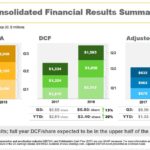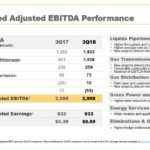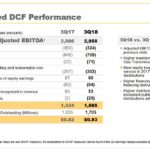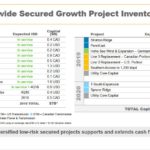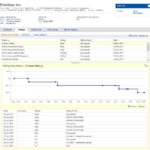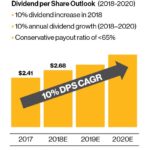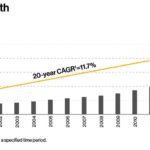Contents
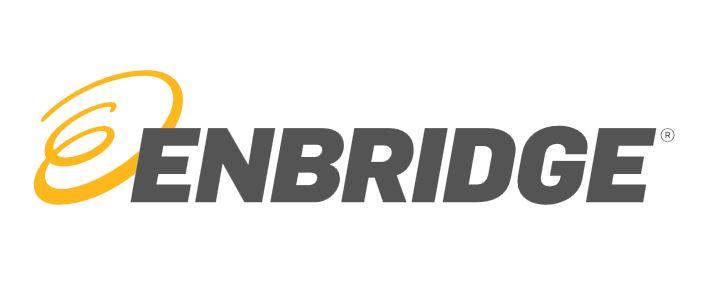 Summary
Summary
- Enbridge released its Q3 results on November 2nd in which it reported a GAAP loss of $0.09B or ($0.05)/share for Q3. This included the impact of a number of unusual, non-recurring or non-operating factors.
- Q3 Distributable Cash Flow (DCF) was $1.585B versus $1.334B for Q3 2017.
- Management reaffirmed FY2018 financial guidance with the DCF/share outlook expected to be in the upper half of the guidance range of $4.15 – $4.45/share.
- ENB expects to complete the simplification of its corporate structure in Q4.
- The divestiture of over $7.5B of non-core assets versus the targeted $3B has satisfied all of ENB’s equity funding requirements for its secured growth program through 2020.
- The recent announcement of the suspension of ENB’s Dividend Reinvestment and Share Purchase Plan is a huge positive.
- ENB has a promising future but investors should be cognizant that it carries a lot of debt.
Introduction
All dollar values expressed in this article are in CDN dollars unless otherwise noted.
I have come across multiple articles in which a writer analyses a company and comes to the conclusion that readers should invest in the company. The writer, however, indicates he/she does not hold a position nor does he/she intend to initiate a position. This puzzles me. I can assure you that if I recommend you invest your hard earned money in a company I either already have a position or I will be initiating a position within the next 72 hours.
FULL DISCLOSURE: 1134 ENB shares are currently held in the FFJ Portfolio.
I encourage you to read my August 4, 2018 Enbridge Inc. post (TSX: ENB) prior to reading this post. In that post I provide a Business Overview as well as my opinion as to why I viewed ENB’s depressed share price as an opportunity for long-term investors.
ENB’s share price has drifted a few dollars/share lower subsequent to that article but I am still of the opinion that ENB is a good long-term investment. In fact, I feel more confident in my ENB investment given the events which have transpired subsequent to that article.
My decision to invest in ENB was based on the fact that ENB operates in a highly regulated industry which results in significant barriers to entry. In addition, this is an extremely capital intensive business (another barrier to entry) but once the infrastructure is in place the business is tantamount to a toll road…revenue literally flows in.
I have previously cautioned readers that:
- ENB’s structure was difficult to understand;
- Not all appropriate approvals for ENB’s Line 3 replacement project had been provided;
- ENB employs a considerable amount of debt.
Fortunately, ENB has taken steps to address those concerns.
This image gives you an indication of the extent to which ENB has been actively involved in addressing its strategic priorities.
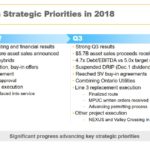 Source: ENB – Q3 2018 Earnings Presentation – November 2 2018
Source: ENB – Q3 2018 Earnings Presentation – November 2 2018
In Q3, ENB reached separate agreements with the Independent Committees of its sponsored vehicles:
- Spectra Energy Partners, LP (NYSE: SEP);
- Enbridge Energy Partners, L.P. (NYSE: EEP);
- Enbridge Energy Management, L.L.C (NYSE: EEQ) and
- Enbridge Income Fund Holdings Inc. (TSX: ENF)
to acquire all of the outstanding equity securities of those sponsored vehicles not beneficially owned by ENB; each separate transaction is targeted to close by the end of Q4 2018.
Details on the simplification of ENB’s structure and the asset monetization which occurred at the beginning of August and October can be found in Section 2 of ENB’s ‘Management Discussion and Analysis’.
ENB’s Line 3 Replacement Program has received extensive press coverage (more details can be found here).
ENB has incurred considerable expense to obtain all the appropriate approvals for this project. Even though approvals are in place, there is still opposition to the project but ENB is proceeding as planned on the segments where approval is in place and there is no opposition.
In my previous article I indicated that ENB has a renewed focus on low risk pipeline and utility businesses and that it’s strategic priorities include:
- the strengthening of credit metrics as industry leading growth capital spend moderates and new projects generate significant EBITDA;
- long-term Consolidated Debt to EBITDA target of 5.0x by end of 2018;
- possible further balance sheet strengthening from additional asset sale proceeds.
In late November of 2017, ENB set out a plan with respect to financing the current $22B secured growth capital program through 2020. That plan included common and hybrid equity issuances as well as $3B of non-core asset sales in 2018 in order to accelerate the planned de-leveraging and to achieve a consolidated Debt to EBITDA ratio of 5.0x by the end of 2018.
ENB has certainly acted swiftly on its strategic priorities having announced over $7.5B of non-core asset sales so far in 2018; this is well in excess of the $3B it had targeted in late November 2017!
By having sold $7.5B in non-core assets, ENB has effectively satisfied all of its equity funding requirements for its secured growth program through 2020. Of this $7.5B, ENB has received ~$5.7B and the balance is expected by mid-2019.
ENB now has additional financial flexibility to further strengthen its balance sheet and fund the secured growth program. As at the end of Q3, ENB’s consolidated Debt to EBITDA ratio was 4.7x on a trailing twelve month basis which is below the 5.0x target by the end of 2018 that ENB had set in November 2017.
Given the substantial progress pertaining to the funding and asset sales plan, I was pleased to read the November 2nd Press Release in which ENB explained the rationale for the suspension of its Dividend Reinvestment and Share Purchase Plan.
Despite the receipt of sale proceeds from the sale of non-core assets, ENB still has a lot of debt on its balance sheet ($58.707B of long-term debt and $0.09B of Other L/T Liabilities as at September 30, 2018). In my opinion, however, I think long-term investors will be aptly rewarded once the major initiatives have been completed. I fully expect ENB to generate strong Free Cash Flow starting in FY2020 which will allow it to make significant inroads to de-risking the Balance Sheet.
On the topic of leverage, the following cautionary note is coming from an investor who avoids the use of debt.
If you happen to be an investor who employs the use of leverage as part of your investment strategy be aware that ENB is highly leveraged. If you decide to borrow to invest in ENB you are, in essence, heaping leverage upon leverage.
There is nothing wrong with that strategy on the condition you fully understand the downside risk which is that debt carries with it a 100% certainty that you will need to repay your obligation yet your investment in ENB carries with it a probability that things won’t pan out as planned.
Q3 2018 Financial Results
ENB’s Q3 results released November 2nd can be accessed here. Management’s discussion and analysis can be accessed here.
The following are but a few key images extracted from ENB’s Q3 2018 Earnings Presentation. I highly recommend you review all pages for more details.
I certainly look forward to the elimination of the sponsored vehicles as this will certainly simplify the earnings presentations.
(Note: ENB previously used ‘Available Cash Flow from Operations’ (ACFFO) but now uses ‘Distributions from Cash Flow’ (DCF). The calculation methodology remains unchanged.)
Source: ENB – Q3 2018 Earnings Presentation – November 2 2018
2018 Guidance
The following are the list of projects in progress or scheduled to proceed.
Source: ENB – Q3 2018 Earnings Presentation – November 2 2018
Credit Ratings
Moody’s and Standard & Poor’s have not amended their credit ratings subsequent to my August 4th article. Moody’s currently rates ENB Baa3 (the lowest tier within the ‘lower medium grade’ category) and Standard & Poor’s rates ENB’s senior unsecured long-term debt BBB+ (the top tier of the ‘lower medium grade’); S&P’s rating is two notches higher than Moody’s assigned rating.
The following image shows the historical ratings Moody’s has assigned ENB. Clearly, the trend has NOT been favorable.
In my opinion, ENB is now making the appropriate strategic decisions to reverse this deteriorating trend in its credit ratings. Once most of its 2019 Strategic Growth Projects have been completed and are generating revenue I envision an upgrade in ENB’s credit ratings will occur in 2021 or 2022.
Source: Moody’s
Valuation
As I compose this article ENB’s TSX listed shares are trading at $41.19 (November 2, 2018 close of business).
Prior to the last few quarters ENB used the term ‘available cash flow from operations (ACFFO)’ in its earnings releases. This has been changed to Distributions from Cash Flow (DCF); the calculation methodology remains unchanged.
When Q2 results were released management had indicated ENB was on track to achieve financial guidance for 2018, with the outlook for DCF/share expected to be in the upper half of the guidance range of $4.15 – $4.45/share. This guidance remains unchanged as at the end of Q3.
On an EPS basis, the consensus current mean adjusted EPS estimate from 9 brokers is $2.62. The disparity in earnings projections, however, is significant ($2.50 – $2.97). Using the $41.19 stock price and the consensus current mean adjusted EPS estimate I arrive at a forward adjusted PE of ~15.72 (the ~13.9 – ~16.5 range is not as wide as at the time of my August 4th article).
If I use the DCF metric management focuses on ($4.15 – $4.45/share), I get a forward Price/DCF range of ~9.26 – ~9.93.
When I wrote my August 4th article, ENB’s TSX listed shares were trading at $46.53 (August 3, 2018 close of business).
On an EPS basis, the consensus current mean adjusted EPS estimate from 8 brokers was $2.49. The disparity in earnings projections, however, was once again significant ($2.19 – $2.70). Using the $46.53 stock price and the consensus mean adjusted EPS estimate I arrived at a forward adjusted PE of ~18.7. (~17.2 – ~21.25 range).
Using the DCF metric management focuses on ($4.15 to $4.45/share) I arrived at a forward Price/DCF range of ~10.46 – ~11.2.
If we go back to my August 7, 2017 article, ENB was trading at $52.57 and 2018 adjusted EPS expectations from multiple brokers was $2.56 thus giving us a forward PE of ~20.54. At the time of that article, management projected DCF of $3.60 – $3.90/share. Using the $52.57 price, the forward Price/DCF range was ~13.48 – ~14.6.
As you can see, ENB’s valuation level is now more favorable for investors than at the time of my previous 2 ENB articles.
Dividend, Dividend Yield and Dividend Payout Ratio
Details about ENB’s dividend and dividend policy can be found at the following site:
http://www.enbridge.com/investment-center/stock-and-dividend-information/dividends-and-common-shares
NOTE: You will need to copy and paste the web address in your browser because the conventional link format I use does not work with this web page.
The current $0.671/quarter or $2.684/year dividend provides investors with a ~6.52% dividend yield. This yield is much higher than the dividend yield I receive from the other stocks I own. I would normally not invest in a company with such a high dividend yield but I am of the opinion this dividend yield will drop once ENB completes its reorganization and completes the major initiatives it has on the go.
Source: ENB’s website
The $2.684/year dividend is ~60.3% – ~64.7% of 2018’s projected DCF. This falls within ENB’s conservative <65% dividend payout ratio.
ENB’s Performance vs S&P500
ENB has grossly underperformed the S&P500 over the short-term; please click on this TickerTech link and plug in your own start and end dates.
This is not surprising given that companies within the utilities sector plod along when compared with companies in most other sectors.
Most investors invest in a utility company for a steady stream of dividend income and lower volatility than that for companies in some other sectors. Parabolic growth in a utility’s stock price is generally not expected so it is not surprising to see ENB’s inferior returns relative to the S&P500 which has been on a tear for the past several years.
Final Thoughts
Anyone investing in ENB should go in with ‘eyes wide open’ as this company has a lot of debt. In my opinion, however, ENB is doing everything management said it would do so as to transform the company.
The company has sold off more non-core assets than it said it would and it is now forging ahead with its Line 3 project. Once this project is completed I envision investors will start to witness a meaningful reduction in ENB’s lofty debt levels.
At the end of my August 4th article I indicated I would acquire another 400 – 500 shares for the FFJ Portfolio’s ‘side account’ within the next 72 hours. I did. I acquired 500 shares and received the first quarterly dividend of CDN $335.50 on September 4th.
I do not intend to acquire additional ENB shares other than through the automatic reinvestment of dividends.
I wish you much success on your journey to financial freedom.
Thanks for reading!
Note: I sincerely appreciate the time you took to read this article. Please send any feedback, corrections, or questions to charles@financialfreedomisajourney.com.
Disclaimer: I have no knowledge of your individual circumstances and am not providing individualized advice or recommendations. I encourage you not to make any investment decision without conducting your own research and due diligence. You should also consult your financial advisor about your specific situation.
Disclosure: I am long ENB.
I wrote this article myself and it expresses my own opinions. I am not receiving compensation for it and have no business relationship with any company whose stock is mentioned in this article.


